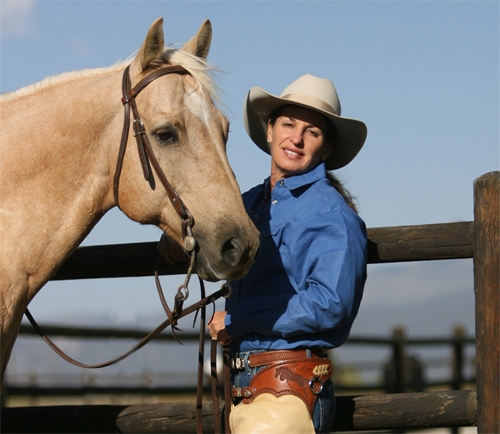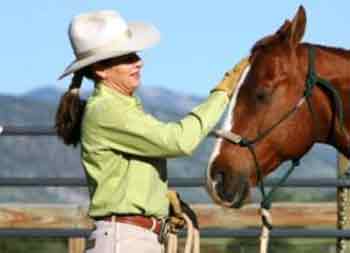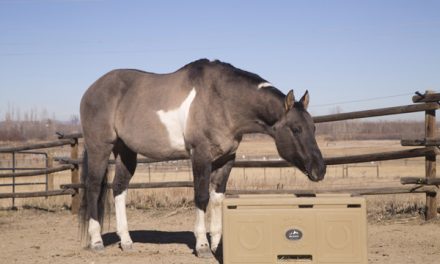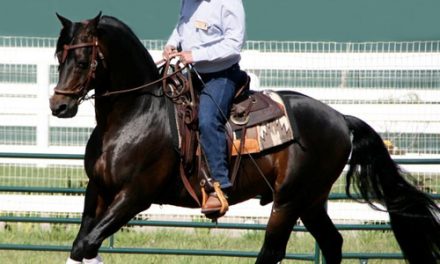C
Riding Right with Julie Goodnight

Dear Julie,
Do you have any suggestions for helping me set my horse’s head? She’s not too bad at home but at shows she raises her head and doesn’t look ideal! I know she wants to look around, but she doesn’t respect my cues to pay attention. How can I get her to keep her head low and perform the same at a show that she does at home?
Hope for a Headset
Dear Hope,
There are several considerations for getting your horse to perform at a show at the same level that she performs at home. There is an article on my website about seasoning a horse for shows that will give you a greater understanding of this training process.
A horse, or any animal for that matter (humans included), goes through four stages of learning:
- Acquisition- horse learns to associate a cue with the behavior you are teaching him (acquires a new skill)
- Fluency- horse responds correctly to the cue almost always and refinement occurs during this stage
- Generalization- horse takes a skill he has learned in one environment and comes to understand that he can perform that skill confidently in any environment (such as at a horse show)
- Maintenance- the “finished” horse will perform reliably in a variety of settings and does not need to learn more, just maintain his skills
Your horse is somewhere between stages one and two and does not yet have the training and experience to perform reliably at shows or away from home (generalization). Stages one and two happen relatively quickly; but to get a horse generalized in his training takes a lot of time and experience.
Horses are very location specific in their training. They tend to associate a specific place with their action or behavior. That is why horses will tend to act up in the same place of the arena. To use this tendency to our advantage, when I am training a new skill to a horse, I might ask her to perform the skill in the same spot where I had success the time before, because I know she is thinking about it there. Then we’ll move on to performing the skill in other places as we move through the stages of learning.
You’ll need to haul your horse to some different arenas for practice in a different setting, then to some horse shows just for schooling (not competition). It can take years to truly season a horse and get him generalized in his skills. Buying a mature seasoned horse is easier and cheaper than seasoning one by yourself!
To get your horse to put her head in a specific place is fairly simple; to get her to keep her head there is a little trickier.
The correction:
To teach your horse to lower her head on command, pick up one rein and lift it up until there is pressure on your horse’s mouth. Use only the amount of pressure that causes your horse to look for a way out of the pressure, which you’ll know because she will start moving her head around trying to find a release.
The instant your horse drops her head, even a fraction of an inch, release the rein and rub her on the neck, then ask again. You must reward any effort on the part of your horse to do the right thing or move in the right direction. First your horse must learn that when you pick up a rein it means to lower her head (acquisition). Once she makes this connection, hold the rein a little longer until the head comes lower, then release. Gradually increase the amount of time you hold the rein up until the head is where you want. Then whenever you want to lower the head, if you lift slightly on one rein, your horse will drop (fluency).
In this process your horse learns that there is a place where she can keep her head and be comfortable (no pressure on the bit) and that if her head is not in that place, she will be uncomfortable (pressure on the bit). For your horse to learn that she must keep her head there, you’ll have to be very consistent in your corrections and have excellent timing for both the release and the correction. That requires a lot of concentration and skill.
If you are having difficulty keeping your horse’s head where you want it, probably you are being inconsistent with your corrections—she doesn’t believe she’ll stay comfortable with her head in the right place and/or that she’ll be uncomfortable with it in the wrong place. Remember, if more than three seconds go by, your horse is unable to make an association between your correction/release and her actions.
One of the very first things I will teach a horse is that she must keep her nose in front of her chest at all times while I am riding her. I don’t care where we are, I will not tolerate a horse looking around—it’s not her job. I am the one in charge and I am the one monitoring the environment; her job is to go where I point her at the speed I dictate. She doesn’t get to make any decisions so she doesn’t need to look around.
Again, consistent correction will take care of this problem very quickly, if you are consistent and have good timing. I use your horse’s points of shoulder as a guideline—she must keep her nose with in those two points. Any time she crosses the line, I will bump the opposite rein until her head comes back to the middle. She can easily see more than 360° around her and still keep her nose between her shoulders. In short order, she’ll quit looking around
We train horses through negative reinforcement—we apply pressure until your horse does the right thing, then we take away the pressure as a reward. In order to influence a horse’s behavior, you have to find the amount of pressure that motivates her to change. For each horse, the amount of pressure required to motivate change is different; if your horse does not respect your hands, you may not be using enough pressure, so it’s easier to ignore your repeated requests than to put her head down.
In training, you must also consider how difficult it’s for your horse to do what you are asking. If it’s an easy skill for your horse to perform, it shouldn’t take much pressure or motivation. If it’s a hard skill, it may take more. Again, this is different with every horse—not every horse is built to keep its head low and/or bring its face to vertical.
The outcome:
Spending some time to season your horse and give her the experience she needs to be comfortable in the show ring is a good place to start. Setting some boundaries and guidelines for her behavior and making it clear to her what she has to do to get the release, will give her a better understanding of what she is supposed to do. This will require a lot of concentration and good timing on your part.
A couple of caveats about headset for shows: don’t ask too much of your horse. Many people showing horses today are asking for extreme and unnatural headsets from your horse, which may make her sore and uncomfortable, and can actually damage the ligaments in her neck.
Letting your horse drop her head straight down is not unnatural but asking it to go down and bring the nose in (breaking at the poll) so that the face is behind vertical IS unnatural and I do not believe a horse should have to do that. However, that is what is commonly seen in the show ring in many disciplines.
Secondly, make sure that your horse gets a release when she does the right thing. Most people do not release your horse soon enough or often enough and that causes your horse to be resistant. Often people are so sure your horse is going to put her head up again (or whatever they don’t want your horse to do) that they hold pressure on the reins trying to prevent it. This will cause a horse to lift his head and be resistant. When a horse gets constant pressure, he will almost always do the opposite of what you want. It’s only if he finds a release that he is motivated to do the right thing.
Good luck with your horse and with a little work, you can teach your horse to perform as well at the show as she does at home. There’s lots of information on my website, www.juliegoodnight.com that can help you along the way.
Enjoy the ride!
Julie Goodnight, Trainer and Clinician




